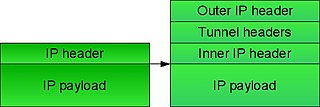Related Research Articles
The Domain Name System (DNS) is the hierarchical and decentralized naming system used to identify computers, services, and other resources reachable through the Internet or other Internet Protocol (IP) networks. The resource records contained in the DNS associate domain names with other forms of information. These are most commonly used to map human-friendly domain names to the numerical IP addresses computers need to locate services and devices using the underlying network protocols, but have been extended over time to perform many other functions as well. The Domain Name System has been an essential component of the functionality of the Internet since 1985.
The Dynamic Host Configuration Protocol (DHCP) is a network management protocol used on Internet Protocol (IP) networks for automatically assigning IP addresses and other communication parameters to devices connected to the network using a client–server architecture.

Internet Protocol version 6 (IPv6) is the most recent version of the Internet Protocol (IP), the communications protocol that provides an identification and location system for computers on networks and routes traffic across the Internet. IPv6 was developed by the Internet Engineering Task Force (IETF) to deal with the long-anticipated problem of IPv4 address exhaustion, and is intended to replace IPv4. In December 1998, IPv6 became a Draft Standard for the IETF, which subsequently ratified it as an Internet Standard on 14 July 2017.
The Session Initiation Protocol (SIP) is a signaling protocol used for initiating, maintaining, and terminating real-time sessions that include voice, video and messaging applications. SIP is used for signaling and controlling multimedia communication sessions in applications of Internet telephony for voice and video calls, in private IP telephone systems, in instant messaging over Internet Protocol (IP) networks as well as mobile phone calling over LTE (VoLTE).
In computer networking, the User Datagram Protocol (UDP) is one of the core members of the Internet protocol suite. With UDP, computer applications can send messages, in this case referred to as datagrams, to other hosts on an Internet Protocol (IP) network. Prior communications are not required in order to set up communication channels or data paths.
In computing, Internet Protocol Security (IPsec) is a secure network protocol suite that authenticates and encrypts the packets of data to provide secure encrypted communication between two computers over an Internet Protocol network. It is used in virtual private networks (VPNs).

Network address translation (NAT) is a method of mapping an IP address space into another by modifying network address information in the IP header of packets while they are in transit across a traffic routing device. The technique was originally used to avoid the need to assign a new address to every host when a network was moved, or when the upstream Internet service provider was replaced, but could not route the network's address space. It has become a popular and essential tool in conserving global address space in the face of IPv4 address exhaustion. One Internet-routable IP address of a NAT gateway can be used for an entire private network.
SOCKS is an Internet protocol that exchanges network packets between a client and server through a proxy server. SOCKS5 optionally provides authentication so only authorized users may access a server. Practically, a SOCKS server proxies TCP connections to an arbitrary IP address, and provides a means for UDP packets to be forwarded.
Zero-configuration networking (zeroconf) is a set of technologies that automatically creates a usable computer network based on the Internet Protocol Suite (TCP/IP) when computers or network peripherals are interconnected. It does not require manual operator intervention or special configuration servers. Without zeroconf, a network administrator must set up network services, such as Dynamic Host Configuration Protocol (DHCP) and Domain Name System (DNS), or configure each computer's network settings manually.
STUN is a standardized set of methods, including a network protocol, for traversal of network address translator (NAT) gateways in applications of real-time voice, video, messaging, and other interactive communications.
In computer networking, Teredo is a transition technology that gives full IPv6 connectivity for IPv6-capable hosts that are on the IPv4 Internet but have no native connection to an IPv6 network. Unlike similar protocols such as 6to4, it can perform its function even from behind network address translation (NAT) devices such as home routers.

An IP tunnel is an Internet Protocol (IP) network communications channel between two networks. It is used to transport another network protocol by encapsulation of its packets.
In computer networking, the multicast DNS (mDNS) protocol resolves hostnames to IP addresses within small networks that do not include a local name server. It is a zero-configuration service, using essentially the same programming interfaces, packet formats and operating semantics as unicast Domain Name Service (DNS). It was designed to work as either a stand-alone protocol or compatibly with standard DNS servers. It uses IP multicast User Datagram Protocol (UDP) packets, and is implemented by the Apple Bonjour and open source Avahi software packages, included in most Linux distributions. Although the Windows 10 implementation was limited to discovering networked printers, subsequent releases resolved hostnames as well. mDNS can work in conjunction with DNS Service Discovery (DNS-SD), a companion zero-configuration networking technique specified separately in RFC 6763.
In the context of computer networking, a tunnel broker is a service which provides a network tunnel. These tunnels can provide encapsulated connectivity over existing infrastructure to another infrastructure.
Anything In Anything (AYIYA) is a computer networking protocol for managing IP tunneling protocols in use between separated Internet Protocol networks. It is most often used to provide IPv6 transit over an IPv4 network link when network address translation masquerades a private network with a single IP address that may change frequently because of DHCP provisioning by Internet service providers.
The Dynamic Host Configuration Protocol version 6 (DHCPv6) is a network protocol for configuring Internet Protocol version 6 (IPv6) hosts with IP addresses, IP prefixes, default route, local segment MTU, and other configuration data required to operate in an IPv6 network. It is the IPv6 equivalent of the Dynamic Host Configuration Protocol for IPv4. DHCPv6 is defined by RFC 8415.
6in4 is an IPv6 transition mechanism for migrating from Internet Protocol version 4 (IPv4) to IPv6. It is a tunneling protocol that encapsulates IPv6 packets on specially configured IPv4 links according to the specifications of RFC 4213. The IP protocol number for 6in4 is 41, per IANA reservation.
An IPv6 transition mechanism is a technology that facilitates the transitioning of the Internet from the Internet Protocol version 4 (IPv4) infrastructure in use since 1983 to the successor addressing and routing system of Internet Protocol Version 6 (IPv6). As IPv4 and IPv6 networks are not directly interoperable, transition technologies are designed to permit hosts on either network type to communicate with any other host.
Port Control Protocol (PCP) is a computer networking protocol that allows hosts on IPv4 or IPv6 networks to control how the incoming IPv4 or IPv6 packets are translated and forwarded by an upstream router that performs network address translation (NAT) or packet filtering. By allowing hosts to create explicit port forwarding rules, handling of the network traffic can be easily configured to make hosts placed behind NATs or firewalls reachable from the rest of the Internet, which is a requirement for many applications.
The Session Initiation Protocol (SIP) is the signaling protocol selected by the 3rd Generation Partnership Project (3GPP) to create and control multimedia sessions with two or more participants in the IP Multimedia Subsystem (IMS), and therefore is a key element in the IMS framework.
References
- ↑ M. Blanchet; F. Parent (February 2010). IPv6 Tunnel Broker with the Tunnel Setup Protocol (TSP). doi: 10.17487/RFC5572 . ISSN 2070-1721. RFC 5572.
- ↑ A. Melnikov; K. Zeilenga, eds. (June 2006). Simple Authentication and Security Layer (SASL). Network Working Group. doi: 10.17487/RFC4422 . RFC 4422. Obsoletes RFC 2222.
- ↑ E. Nordmark; R. Gilligan (October 2005). Basic Transition Mechanisms for IPv6 Hosts and Routers. Network Working Group. doi: 10.17487/RFC4213 . RFC 4213. Obsoletes RFC 2893.
- ↑ A. Conta; S. Deering (December 1998). Generic Packet Tunneling in IPv6 Specification. Network Working Group. doi: 10.17487/RFC2473 . RFC 2473.